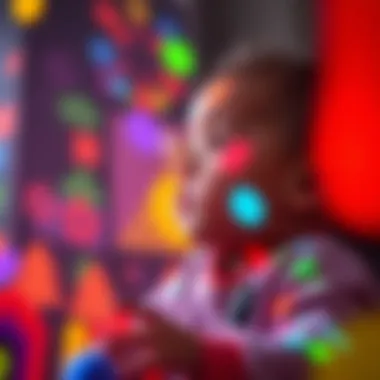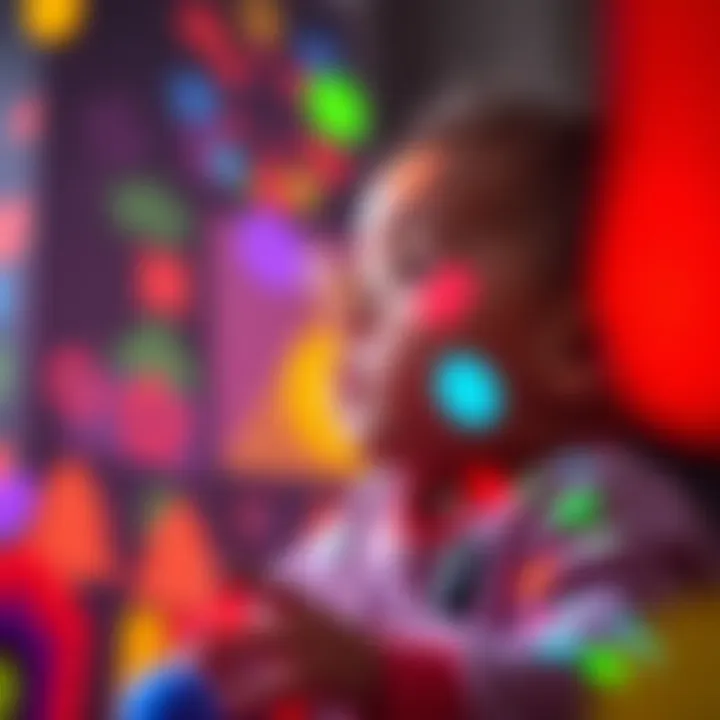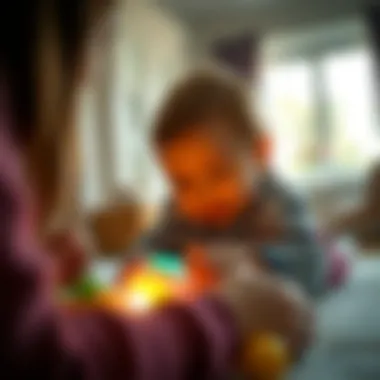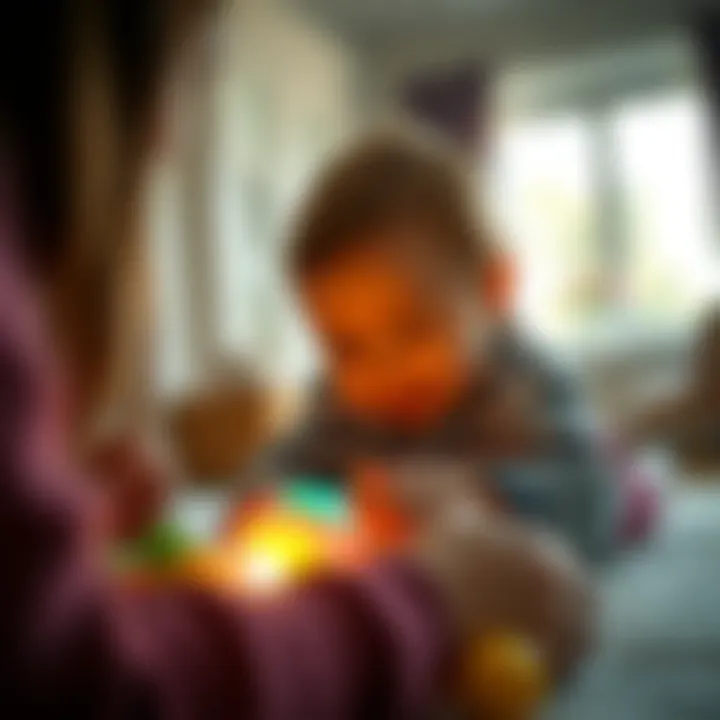Infant Visual Stimulation: Importance and Impact


Intro
Visual stimulation during infancy is a pivotal topic of exploration, often overshadowed by other aspects of early childhood development. However, the ways in which an infant engages with the visual world can significantly shape their cognitive abilities and sensory perceptions. As the brain undergoes rapid growth in the first few years, the inputs it receives play a vital role in determining how effectively it develops. This article unpacks the intricate relationship between visual stimulation and cognitive growth, emphasizing how understanding these dynamics can not only enhance everyday childcare practices but also contribute to an infant's long-term developmental trajectory.
Infancy is a critical period when visual pathways are formed, and engaging with colorful shapes, contrasting images, and varied movements becomes crucial. With the increasing prevalence of screens in modern environments, it has never been more important to discern effective visual stimulation methods that support healthy development. The journey of understanding begins with a solid foundation in the research surrounding this topic, which reveals not just the 'what' but also the 'why' behind visual experiences in early life.
Overview of Infant Visual Stimulation
Visual stimulation plays a crucial role in the development of infants, impacting their cognitive abilities and sensory perception. Understanding how infants engage with their surroundings provides insight into their learning processes and emotional growth. By creating an awareness of this topic, parents and caregivers can foster an environment that supports healthy development.
Definition and Scope
Visual stimulation refers to the variety and intensity of visual input available to an infant. It includes colors, patterns, shapes, and the movement of objects. This sensory experience shapes how infants interpret the world. When discussing visual stimulation, it is essential to recognize its spectrum—from simple, high-contrast images to more complex visual aids such as toys or multimedia content.
The scope of visual stimulation in early childhood is broad. It encompasses natural observations—like watching leaves flutter in the breeze—to more crafted interactions involving toys or books designed to capture attention. Each form of stimulation has distinct implications on growth. Parents should strive to balance environmental exposure with personalized interaction, ensuring that the visual input aligns with what is developmentally appropriate for their child.
Historical Perspectives
Historically, the value of visual stimulation in infant development has evolved significantly. In previous centuries, the understanding of child development was limited largely by the tools available to researchers and caregivers alike. Early theories emphasized the role of sensory experiences in shaping an infant's perception, but specific methods were not formally recognized until the 20th century.
In the 1960s and 1970s, psychologists began to delve deeper into the effects of sensory experiences. Notable studies illustrated how visual stimulation affected brain connectivity and cognitive functioning. Over the decades, the relevance of early experiences gained traction, leading researchers to explore the complexities of learning and attachment.
Recognizing that infants are not merely passive recipients of external stimuli, but active participants in their developmental journey is a key shift in perspective. This development has led to the creation of more intentional methods for engaging infants visually, from educational toys to innovative nursery designs. In the 21st century, technological advancements further enrich the exploration of visual stimulation, prompting ongoing discussions around appropriate usage.
Overall, understanding the definitions, scope, and historic context lays the groundwork for comprehending the multifaceted nature of visual stimulation and its profound impact on a child's development. Individuals seeking deeper insights into this topic may find valuable resources on platforms such as Wikipedia and Britannica.
"The interaction of visual stimuli contributes substantially to the overall growth and learning capabilities of infants, laying the foundation for lifelong skills."
The Developmental Significance
When we delve into the developmental significance of visual stimulation in infants, we uncover layers of benefit and importance that stem from their early experiences. A child's interaction with visual stimuli plays a key role in shaping their cognitive abilities and sensory experiences. It’s astounding how something as simple as a brightly colored mobile can influence brain pathways that are crucial during those formative months.
Cognitive Development
Role of Visual Cues
Visual cues serve as signposts for infants navigating the world around them. They allow young minds to form connections and establish understanding of their environment. When you think about visual cues, consider how infants respond to high-contrast patterns or familiar faces. These cues are not just visuals; they're foundational elements that promote curiosity and exploration. The ability to distinguish between different shapes and colors enhances cognitive pathways essential for problem-solving later in life.
One of the charming aspects of visual cues is their simplicity. Bright colors and sharp contrasts are not merely for aesthetics; they significantly capture an infant's attention. It’s as if bright colors spark a light bulb moment in their brains, driving engagement and allowing for learning to occur almost effortlessly. However, it’s crucial to strike a balance; too much stimulation can overwhelm an infant rather than aid their development.
Impact on Memory
Memory in infants is not fully formed, but the seeds of recall are planted early through repeated visual exposure. When infants are regularly shown images of their caregivers or familiar objects, they begin forming mental associations that lay the groundwork for recall. Essentially, visual memory paves the way for recognizing loved ones and eventually remembering past experiences.
A striking trait of this memory impact is its long-lasting effects. Research suggests that early visual exposure can influence later memory skills, playing a pivotal role in overall cognitive development. However, it's not all sunshine and rainbows; if memories are formed around negative or frightening visuals, it may lead to anxiety or fear responses that linger into later stages of life.
Shape Recognition
Shape recognition is another critical aspect of cognitive development influenced by visual stimulation. As infants engage with various shapes—be it through toys or everyday objects—they learn to distinguish between different forms. This skill merits attention, as recognizing shapes is foundational not only for visual skills but also for numeracy and literacy development.
The fascinating feature about shape recognition is the possibility for it to enhance spatial awareness. When infants understand shapes, they become better equipped to navigate their environment as they grow. Nonetheless, one ought to be cautious about overwhelming infants with too many shapes at once. Too much variety can lead to confusion rather than clarity.
Sensory Integration
Coordination of Senses
As infants experience visual stimulation, they concurrently engage other senses. This coordination of senses is paramount as it lays the groundwork for a comprehensive understanding of the world. For instance, when a baby gazes at a colorful rattle and reaches for it, they are integrating visual cues with touch. Such interactions enhance their physical and cognitive skills side by side.
A standout aspect of this coordination is the holistic growth it promotes. Children learn better when they utilize multiple senses simultaneously. They don't just see; they feel, hear, and eventually start to connect their sensory experiences in intricate ways. However, relying solely on visual stimulation without engaging other senses could inhibit a well-rounded developmental experience.
Interplay with Other Sensory Inputs


The interplay between visual and other sensory inputs cannot be underestimated. As infants grow, their abilities to link visual information with sounds or tactile experiences deepen. For example, the sound of a bell accompanied by vibrant visuals can create associations that strengthen memory.
This intertwining of senses facilitates richer learning experiences. However, it’s essential to refrain from saturating their environment with too many sensory signals. Overstimulation can lead to frustration and withdrawal, which can counteract the benefits of sensory integration. Finding the sweet spot of sensory input is key to fostering a stimulating yet manageable environment for infants.
By understanding the developmental significance of these processes, we can better appreciate how vital early visual stimulation is to cognitive and sensory growth. Parents and caregivers should take heed of the simple yet profound ways they can influence a child's formative experiences—setting the path for a thriving future.
Visual Stimulation Methods
The different methods of visual stimulation play a crucial role in how infants engage and respond to their surroundings. Engaging an infant's vision isn’t just about making things look pretty; it’s about facilitating development. Each method brings unique benefits that can enhance cognitive engagement and sensory perception, laying the groundwork for further learning.
Natural Environment Stimulation
Colorful Surroundings
Colorful surroundings, indeed, make a difference for infants. It’s not merely about splashes of color; it’s how these colors tie into the baby’s burgeoning perception. Bright and varied hues capture attention and can excite an infant’s sensory system. The key characteristic of colorful environments is that they stimulate emotional responses, making babies feel more at ease while exploring new visual tapestries.
The unique feature of colorful surroundings is their ability to provide constant engagement without overwhelming the child. Studies suggest that babies are drawn to highly saturated colors, like reds and blues. These vibrant shades help in developing their color recognition skills. However, over-reliance on artificial stimulations with too much brightness may lead to overstimulation, making it a double-edged sword.
Movement and Change
Movement and change in a visual field prompt infants to focus and track images, fostering essential motor skills. Their eyes might instinctively follow a swaying toy or the gentle motion of leaves in the wind. This dynamic aspect of surroundings supports eye coordination and tracking skills. It’s beneficial because it helps infants understand cause and effect—the more things move, the more they realize they can engage with the world.
A unique feature of this method is its unpredictability. Sudden movements can grab an infant’s attention and spark curiosity. This appeal helps babies to better understand patterns in their environment, making them more adapt to changes. However, too much unanticipated swift motion can create confusion, making balance essential in the environment.
Toys and Visual Aids
Appropriate Toys
When it comes to selecting appropriate toys for visual stimulation, the focus should be on those designed specifically for infants. Toys with various colors, shapes, and textures serve as effective tools for encouraging visual tracking and hand-eye coordination. The primary characteristic of these toys is that they cater to the developmental stage of infants, pointing out simple shapes and bright colors engaging early learning devices.
One unique advantage of appropriate toys is that they not only entertain but also promote multisensory learning. That means they can be especially fun while developing cognitive skills. However, not all toys are created equal. Complicated designs or overly detailed toys may overwhelm rather than stimulate an infant’s visual interest, underscoring the importance of careful selection.
Books and Images
Books and images serve as an avenue for visual exploration that extends beyond simple toys. The simple act of reading to an infant, with pictures of animals or shapes, greatly contributes to their visual development. The key feature here is that illustrated books often have large images and few words, perfectly crafted to capture an infant’s attention.
The benefit of using books is they can be a catalyst for stimulating conversation and bonding through visual storytelling. This interaction can also promote language skills. However, sticking to overly complex narratives can detract from the visual experience. It's essential to maintain simplicity to keep an infant engaged and responsive.
Multimedia and Technology
Potential Benefits
In today’s world, multimedia is becoming more prominent in how we stimulate visual engagement in infants. There’s no denying that devices such as tablets and screens can present a wealth of vibrant, moving images that instantly catch an infant's attention. The characteristic here is the combination of sound and visuals that can engage several senses at once, promoting an immersive experience.
Additionally, potential benefits include access to educational content designed for varying developmental stages. Programs that utilize colorful animations and engaging narratives can keep an infant interested. However, moderation is key. Too much screen time can inhibit natural exploration.
Limitations and Risks
Still, when it comes to multimedia, all that glitters is not gold. There are limitations and risks associated with prolonged exposure to screens. While visual stimuli can enhance engagement, it's essential to recognize that it can lead to overstimulation, displacing real-world interactions. The glaring nature of screens can be taxing on an infant’s developing eyesight.
The unique feature of this limitation is its immediacy—infants can be entranced but not fully engaged in real-world interactions. A balance between multimedia exposure and direct human interaction is necessary to foster overall development. Too much focus on screens may hinder the development of tactile skills or emotionally intimate connections through shared experiences.
Influencing Factors on Visual Stimulation
Understanding the factors that influence visual stimulation in infants is crucial for comprehending their developmental needs. These factors can shape how babies engage with the world around them, impacting their cognitive and perceptual growth significantly. To unravel this complex interaction, we examine the roles of parental interaction and cultural variations.
Parental Interaction
Active Engagement
Active engagement refers to the direct involvement of caregivers in a child's visual experiences. When parents actively stimulate their infants through eye contact, playful interactions, and responsive gestures, they create an environment saturated with visual and emotional cues. This dynamic engagement not only amplifies visual interest but also fosters a secure attachment between the infant and the caregiver.


The key characteristic of active engagement is its immersive nature. Infants benefit from real-time feedback that guides their focus and attention. Often favored for its simplicity, it allows parents to bond with their children while enhancing the baby’s visual capacity. The unique feature of this approach is how it personalizes the experience—each interaction becomes a lesson, a game, or an exploration. The obvious advantage is the immediate interaction it provides, helping to build neural pathways essential for visual processing.
However, there are some disadvantages to note. Overzealous attempts at engagement might lead to overstimulation, overwhelming the child instead of aiding development. Thus, balance is critical in this interaction.
Responsive Behaviors
Responsive behaviors encapsulate the actions taken by caregivers in reaction to the infants’ cues. This includes responding to an infant's gaze or following their line of sight to foster further engagement. Such behaviors serve as an essential part of visual stimulation, as they validate the infant’s explorations and encourage ongoing interaction with visual stimuli.
The key characteristic of responsive behaviors lies in their attentiveness to the baby’s needs. This responsiveness helps infants understand the social dimensions of visual engagement. It can be seen as a popular choice because it nurtures both cognitive and emotional development simultaneously. One unique feature of this practice is its adaptability—caregivers can tailor their responses based on individual infant cues, providing tailored stimulation.
While the advantages are clear, such as improved social interaction and emotional regulation, there’s the potential challenge of inconsistent responsiveness due to parental stress or distractions, which may disrupt the communicative loop.
Cultural Variations
Differences in Exposure
Cultural variations play a significant role in shaping infants’ visual experiences. Differences in exposure highlight how infants from diverse backgrounds might interact with their environments uniquely. For instance, a child raised in a vibrant urban area may be surrounded by fast-paced visual elements, contrasting with those in rural settings who might see more natural landscapes.
The key characteristic here is the diverse range of stimuli that affects cognitive development. Such exposures can enhance visual processing skills and establish varying preferences for certain colors, shapes, and patterns. It holds significant weight in this discussion due to the breadth of experiences it encompasses.
A unique feature is how these differences can either hinder or foster development; an infant exposed to a rich array of visual stimuli may thrive, while the opposite may be true in environments lacking diversity. Understanding these dynamics helps parents and educators adapt their approaches based on cultural context.
Cultural Artifacts and Symbols
Cultural artifacts and symbols contribute another layer to visual stimulation. These elements encompass paintings, toys, clothing, and various symbols that carry specific meanings within a culture. By introducing infants to these cultural markers, caregivers can enhance their visual and cognitive development as they begin to interpret meaning.
This aspect is pivotal for its role in socialization processes. The key characteristic of cultural artifacts is their ability to carry narratives and conventions of the society they represent. They’re an effective choice for this discussion because they link visual stimulation to broader cultural literacy and context. One notable unique feature of these artifacts is how they promote familiarity with objects and symbols significant in a child's life.
Advantages include building a sense of identity and belonging. Nevertheless, an undue focus on narrow cultural symbols can limit exposure to a broader visual spectrum, possibly stunting diverse cognitive growth.
The intersection of parental interaction and cultural context is vital; both, working in synergy, lay the groundwork for robust visual-stimulating environments that ultimately support infants’ overall development.
Possible Risks and Concerns
Understanding the potential downsides of visual stimulation is just as vital as recognizing its benefits. Adequate visual engagement can promote healthy development, but if taken too far, it can have negative impacts on an infant's growth. In this section, we explore the challenges associated with visual stimulation, such as overstimulation and visual impairments. By acknowledging these risks, caregivers can create a balanced environment that enriches the developmental experience without overwhelming the infant.
Overstimulation
Overstimulation occurs when an infant receives too much visual input all at once. This can lead to stress and confusion, inhibiting rather than supporting healthy growth. Signs of overstimulation may manifest as irritability, fussiness, or an inability to focus on particular objects.
A critical aspect to understand here is that infants are not yet capable of processing complex visuals or sudden changes in their environment. Too many bright colors, moving objects, or loud sounds can create a chaotic atmosphere. Parents and caregivers need to recognize that while variety can be stimulating, excessive stimuli can lead to discomfort for the infant.
To mitigate overstimulation, caregivers can:
- Provide a calm, soothing environment.
- Limit the exposure to fast-moving visuals.
- Schedule quiet time after active play sessions.
Taking these simple precautions can strike a balance, ensuring the infant's exposure is both enriching and manageable.
Visual Impairments
Visual impairments can affect an infant's ability to process visual information properly. Early detection is key to addressing these issues effectively, allowing for timely intervention and support. Parents need to remain vigilant and aware of their child's visual responses. If an infant shows signs of struggling to track moving objects or seems indifferent to visual stimuli, it’s crucial to consult a professional.
Early Detection
Early detection of visual impairments can significantly influence an infant's developmental trajectory. The earlier these impairments are identified, the better the chances of effective intervention. A key characteristic of early detection is that it often involves regular screenings during pediatric checkups. These screenings evaluate how well the infant can see and process visual information.
For many parents and caregivers, getting their infant’s vision checked can feel like a daunting task. However, it is a beneficial choice that contributes immensely to future learning and development. By identifying potential issues in their infancy, caregivers can take necessary actions, making it easier for the child to thrive.
Preventive Measures
Preventive measures play a critical role in minimizing the risk of visual impairments. These measures can include simple yet effective strategies such as:


- Ensuring proper lighting during playtime so as not to strain the infant’s eyes.
- Limiting screen time with devices like tablets or televisions until the child is older.
- Encouraging outdoor play, which allows for natural light exposure and improves visual health.
Taking these proactive steps fosters a healthier environment for the infant, helping them navigate the world visually without undue stress or strain.
Long-Term Effects of Visual Stimulation
Visual stimulation during infancy is not merely an amusing aspect of early developmental experiences; it lays a foundational role in shaping numerous capacities that come into play as the child grows. Understanding this value is essential for parents, educators, and caregivers as they navigate the complex landscape of infant development. The effects of visual stimulation resonate through learning, social interactions, and emotional maturity, rippling into the future.
Impacts on Learning
Critical Periods of Development
Critical periods refer to specific time frames during which infants are particularly receptive to certain types of learning and development. In the context of visual stimulation, these periods are crucial, as visual experiences can significantly influence neural pathways. For instance, exposure to various shapes, colors, and movements during these windows aids in forming essential neurological connections.
One key characteristic of critical periods is their limited duration; after these windows close, the opportunity for certain developmental growth diminishes. This phenomenon is often discussed in relation to language acquisition, but its alignment with visual stimuli cannot be understated.
In this article, the discussion on critical periods highlights how early proper visual input can favorably set the stage for enhanced cognitive processing later on. A unique feature that stands out is how early visual experiences have long-lasting benefits on brain development, ultimately creating pathways that support complex learning tasks. However, neglecting these opportunities might lead to disadvantages such as difficulties in cognitive skills or perceptual capabilities later in life.
Influence on Academic Performance
Academic performance is another realm where the effects of visual stimulation manifest prominently. Beyond early experiences, the role of visual stimuli extends into how children engage with learning materials and environments within educational settings. Infants who receive adequate visual stimulation often show improved skills in areas like spatial awareness and problem-solving.
A notable characteristic of this aspect is that it integrates directly into how children process information, influencing their ability to absorb new concepts and ideas. High-quality visual experiences can engage a child’s curiosity, thus fostering a more profound love for learning, which is beneficial for academic pursuits in the long haul.
The unique feature to consider here is the correlation between enhanced visual engagement in infancy and higher levels of academic success. This relationship underscores the necessity for a thoughtful approach to visual stimulation—too little can hinder development, yet too much can lead to distraction. The balance is essential, and drawing insights from these observations serves as a guide for parents and educators alike, ensuring they provide enriching visual contexts without overwhelming children.
Social and Emotional Growth
Formation of Relationships
The process of forming relationships is intricately linked to visual stimulation. Infants rely on visual feedback not only to understand the world around them but also to develop connections with caregivers and peers. Infants learn social cues through facial expressions, body language, and other visual prompts.
One critical aspect of forming relationships involves recognizing emotions through visual signals. This is significant because the ability to understand others emotionally plays an essential role in developing empathy. A fundamental characteristic here is that early visual interactions help children practice responding to these visual cues, shaping their social skills in later stages of life.
The unique feature of this process is the observation that infants who have rich visual experiences often exhibit stronger relational skills—forming bonds and understanding boundaries more adeptly than those with limited interactions. However, one must be careful that dependency on visual cues does not override the importance of verbal and physical interactions in relationship building.
Understanding Emotions
Understanding emotions is a critical aspect of social and emotional growth facilitated by visual stimulation. From recognizing sadness in a caregiver's eyes to responding to smiles, infants develop emotional intelligence largely through visual experiences.
The key characteristic of this journey into emotional understanding is that infants are adept at picking up on subtle visual cues; their brains are wired to interpret what they see. Understanding faces, both familiar and unfamiliar, teaches kids the nuances of human behavior. It’s a beneficial process, as it not only fosters a sense of security in infants but also prepares them for social engagements in broader contexts.
Additionally, a unique feature of this emotional development is that it bridges the gap between visual perception and emotional literacy. When infants engage with a variety of visual stimuli, they cultivate the ability to interpret emotions not just in themselves but in others as well. Missing out on such opportunities can hinder emotional development, leading to challenges in future social interactions and relationships.
"The journey of understanding emotions is grounded in the visuals we encounter, shaping our societal bonds and reactions."
Visual stimulation during infancy goes beyond the immediate benefits; it constructs the very framework for lifelong learning, relationships, and emotional comprehension. Fostering an environment rich in appropriate visual experiences can pave the way for healthier social and cognitive development as children grow. The implications are vast and ripple into every facet of life, making this aspect of early childhood development one of the most insightful and critical areas for study and practice.
End
In wrapping up our exploration of infant visual stimulation, it becomes clear just how crucial this aspect of development really is. The significance of visual input cannot be understated; it's not just a luxury but a necessity for growth. Through various forms of visual engagement, infants acquire fundamental skills that will serve them throughout their lives. We need to consider how these early experiences shape cognitive processing, the way they learn to interact socially, and even their emotional well-being.
"The seeds of cognition are sown in the earliest moments of life."
One vital element we’ve discussed is the profound overlap between visual stimulation and other areas of development. Insights show that when infants are exposed to vibrant colors, moving objects, or interactive visuals, they're not merely watching—they're learning. This interactivity encourages them to make connections, enhances their memory capabilities, and aids in recognizing shapes and patterns, which are foundational for later learning.
Recap of Key Points
- Role in Cognitive Development: Visual stimuli boost cognitive skills like memory and shape recognition. Such engagement lays the groundwork for advanced learning as they grow.
- Importance of Sensory Integration: Coordination between visual input and other senses is vital. Infants learn to form a holistic view of their environment.
- Effects of Overstimulation: Too much visual input can create confusion. It’s essential to maintain a balance to foster a healthy developmental pace.
- Cultural Influences: Different cultures offer various visual stimuli, showcasing how environment impacts cognitive development.
- Long-term Outlook: The effects of visual stimulation can lead to improved academic performance and emotional intelligence in later years.
Future Directions in Research
Future research must delve into the fine details of this subject, particularly focusing on underexplored areas such as:
- Longitudinal Studies: Observing infants over time to understand how early visual experiences translate into long-term outcomes. Studies might focus on the specifics of how different forms of visual stimulation affect various learning styles as an infant progresses into childhood.
- Technology’s Role: Investigating the implications of increasingly screen-oriented environments. Are traditional toys overshadowed by multimedia tools? What balance should modern parents aim for?
- Cross-Cultural Studies: Comparing the effects of visual stimulation across different cultures could offer insights into how broader societal factors influence cognitive development.
- Targeted Interventions: Developing specific methods that could be employed in diverse settings aimed at improving visual engagement for infants at risk of developmental delays.
Through understanding these dimensions, we can build a more robust framework around infant visual stimulation, creating opportunities for researchers, educators, and caregivers alike to foster richer environments for developing minds. As the landscape of care continues to evolve, the call for informed approaches that honor both tradition and innovation becomes ever more pressing.
By viewing visual stimulation as a key player in child development rather than an isolated factor, we can better appreciate the roadmap that guides infants through their formative days.







